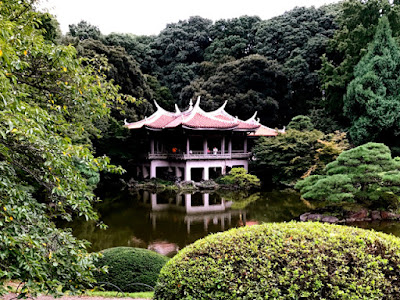Stations, Shrines, and Gardens
This morning when we first awoke, we had no agenda for the day, other than to take it easy. We got up around 8:00 am. While I worked on the blog that I was too tired to write last night, Russ worked on fleshing out today and tomorrow's agenda of places to go and things to do.We sat at the kitchen table until almost 11:00 am working on our separate projects, and then went out to explore Shinjuko. First stop would be the Japan Rail Office at the Shinjuko Station; second stop would be the Meiji Jingu Shrine and Garden; third stop would the Shinjuko Gyoen Gardens. Both of us look forward to walking in the woods and gardens. But this is a shoulder season between summer and fall so we were probably not going to see any flower blossoms or falls leaves. Actually, we weren't sure what we would see.
Russ and I set off on foot what should be about a 6km walk from our apartment to Meiji Jingu Garden via the the Shinjuku station. With twists, turns, and back tracking here and there, it was probably closer to a 10 km (6 miles) walk including our wandering in the Gardens.
Along the way:
Befor we got under way we wanted to check out the garbage disposal areal outside of our apartment. For such a tiny kitchen we have four large waste bins where we are to separate trash into bottles and and cans, an burnable garbage. We hope to find out what burnable garbage is, and if plastic yogurt containers are categorized with bottles and cans or are considered burnable garbage. In the apartment these are only alternatives. We think looking at the recycle bins downstairs will help us figure this out. It doesn't. It only makes it more confusing.
 |
| The writing is in Japanese, and there are many more categories that the two we have in our apartment. |
There are approximately 13 million people in Tokyo. Streets are busy, parking is a premium. Most of the folks by the time we are walking down the sidewalk have already gotten to their workplace in the bustling city. We see a few entrances to car parking lots with turntables (didn't see this action so not sure how it works),
and saw hundreds and hundreds of bicycles parked and locked up and down the sidewalk.
 |
| Didn't see anyone using this relic. |
 |
| Like the Brits, the Japanese drive on the left. Love the Fir Trees on the city Streets. |
 |
| Always a train going by. |
 |
| Everyone walks across this intersection at the same time. |
Shinjuku Station:
We arrived at the Shinkjuko station and found the Japan Rail Office where we registered our 14 day rail pass that will begin on Friday, September 22 as we head out of Tokyo to Hakone near Mt. Fuji. We also collect some tourist information from the visitor center. By then it was almost 1:00 so we stop for lunch at a nearby Starbucks, and then continue on to Meiji Jingu shrine.
Meiji Jingu Shrine and Garden
 |
| Beautiful shaded walk through the towering trees |
The shrine is a Shinto commemoration to the divine souls of Emperor Meiji and his Empress, Shoken, who both died in the early 20th century. Shinto has no founder, holy book, and not even the concept of religious conversion. It is based on Shinto values, for example harmony with nature, and magokoro (sincere of heart). Meiji was loved by his people. Before entering the Shrine, the devoted faithful, wash their hands and clean their mouths.
The Shrine is currently under restoration, and we could not see much beyond the construction screens in front of the buildings, only the large central courtyard.
The inner garden predates the Meiji Jingu shrine in the 15th century inhabited by the Li Clan. We see the famous well from the Edo period. It is believed to have been made by the famous Samruai, Kiyomasa Kato 1562-1611. The water still bubbles up crystal clear from the spring and was said to have been used for the Emperor's tea.
 |
| Hard to believe there is over a foot of water on top of the rocks in the well. Only reflection on top surface gives it away. |
The only blooms in the garden during this time of year are water lilies.
Nevertheless, the gardens are a peaceful and verdant oasis in the middle of a very busy city.
Shinjuku Gyoen National Garden
This beautiful garden was that of Feudal Lord Nato in the Edo Era (15th-16th century). The garden was restored as an imperial garden in 1906 and became the Natioanal Garden after World War II.
The Japanese garden is considered the most important garden from the Meiji era. It is a peaceful place and we can almost forget that we are still in the middle of a large metropolitan city except for occasional city siren and the reflections of sky scrapers in the serene ponds and lakes.
 |
| I am so tired of seeing selfie sticks and people mugging in front of every picture they take. |
 |
| Beautiful reflections. |
After a day of walking around in the city's oasis, we head back to our apartment. I am sure we have covered at least 12 miles round trip and feel justified having a glass of wine for dinner. Tomorrow, we will head further into Tokyo (dress rehearsal for when we leave for Hakone on Friday), for an afternoon bicycle tour of the city.




























































